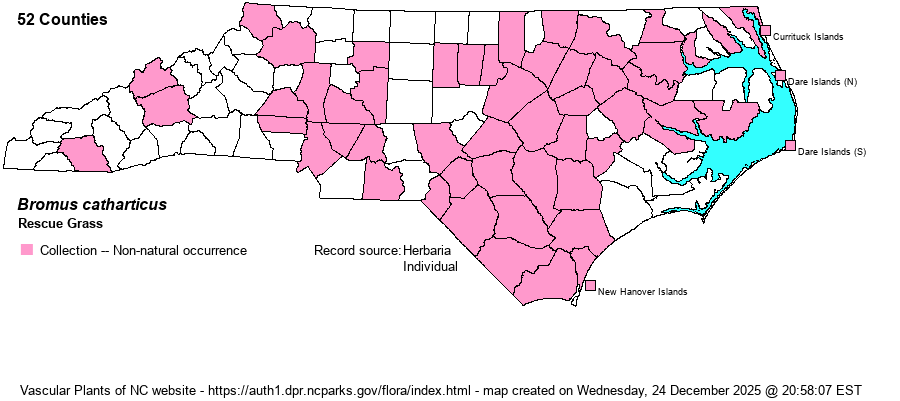| Author | Vahl | |
| Distribution | Mostly Coastal Plain, Sandhills, and Piedmont; apparently scarce in the Mountains. Gaps in the former regions will likely be filled in.
Native to South America; in N.A. from NJ to OR and south to FL, TX, and CA. | |
| Abundance | Frequent to locally common in the western Coastal Plain and Sandhills; rare in the low Mountains. | |
| Habitat | Meadows, fields, cropfields, roadsides, disturbed soils. | |
| Phenology | Flowering and fruiting April-July. | |
| Identification | Rescue Grass grows 2-3 feet tall, with a relatively narrow terminal inflorescence (branches strongly ascending to nearly erect). The lemma awns are absent or short (a maximum of 10 mm long). Unlike our other Bromus species, the spikelets are compressed laterally (rather flattened) -- a distinct feature. | |
| Taxonomic Comments | Bromus is an important genus of grasses for their value as forage (many species) or for the harm they cause to the guts of grazing animals (a few species). In most of our species, inflorescences arch over and cause the spikelets to droop; thus the plants are often graceful looking. Bromus, Festuca, and Poa all can look quite similar to beginners (and even veterans!), because they all have multi-flowered spikelets. Generally speaking, Bromus taxa have much the largest spikelets, and most Poa taxa have a tuft of wispy hairs at the base of each floret (lacking in the other genera). Bromus and Festuca taxa have obvious awns on the florets that are absent in Poa taxa. With field experience and careful use of keys, one can eventually handle these genera. | |
| Other Common Name(s) | | |
| State Rank | SE | |
| Global Rank | GNR | |
| State Status | | |
| US Status | | |
| USACE-agcp | | |
| USACE-emp | | |

